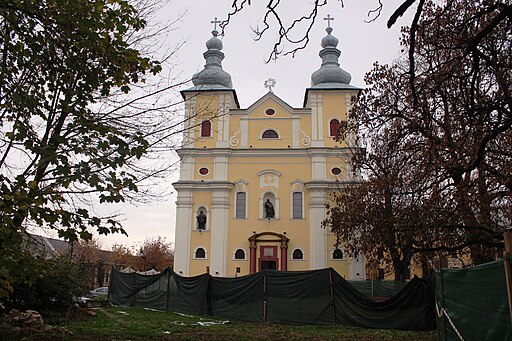Holy Trinity Former Jesuit Church and Monastery
Holy Trinity Former Jesuit Church and Monastery
Original function:
church and monastery
Historical Hungarian county:
Szatmár
GPS coordinates:
47.6584918582, 23.5832022679
History
The old Jesuit church included a convent and a school. The old school gym was converted into an Orthodox church in 1926 after the Romanian occupation. The church was built between 1717 and 1720. In 1773, the Pope dissolved the Jesuit order, and since then it has been a parish church.
The Jesuits appeared in Nagybánya in 1674, when the imperial military took the church of St. Stephen from the Calvinists and gave it to the Jesuits. The Jesuits were expelled in 1677.
In 1687, after the Turks had been driven out and Transylvania had been incorporated into the Habsburg Empire, St Stephen's Church was acquired by the Catholics and taken over by the Jesuits in 1691. Thanks to the Hungarian War of Independence led by Rákóczi Ferenc II, the Calvinists were able to use St. Stephen's again from 1705 to 1712. Afterwards the Jesuits reclaimed it, but did not have it restored, but built their new church on the site of the old St. Martin's Church. The Jesuit church and monastery were built thanks to a donation from Bishop Matyasovszki László of Nitra in 1696, and an oval-shaped memorial plaque was placed on the western facade in commemoration of the donation. St Stephen's Church was then torn down and was blown up in 1847. The altarpiece of the sanctuary was painted by Kármán László in 1823. The altar was carved by Schaintzer Fülöp in 1824-25. The monastery and school building was completed by 1748. The school was taken over by the Minorites in 1776. The church was completely renovated between 1852 and 1867 by the parish priest Smoczer Ignác, when the new main altarpiece was also made. At the beginning of the 20th century, the mosaic floor and the eight-coloured glass window were completed. The organ was completed between 1940 and 44, when Nagybánya was again part of Hungary.
After the First World War the school, then a state grammar school, moved. It was replaced by a civil school for girls.
{"item":"sight","set":{"sightId":1130,"townId":55,"active":1,"name_LO":"","address":"Strada 1 Mai 6","mapdata":"1|827|805","gps_lat":"47.6584918582","gps_long":"23.5832022679","religion":1,"oldtype":"9","newtype":"1","homepage":"","openinghours":"","muemlekemlink":"https:\/\/www.muemlekem.hu\/hatareset\/Szentharomsag-plebaniatemplom--volt-jezsuita-templom-es-kolostor-Nagybanya-1529","csemadoklink":"https:\/\/lexikon.adatbank.transindex.ro\/muemlek.php?id=182","picture":"\u003Ca title=\u0022Rlevente, CC BY-SA 3.0 <https:\/\/creativecommons.org\/licenses\/by-sa\/3.0>, via Wikimedia Commons\u0022 href=\u0022https:\/\/commons.wikimedia.org\/wiki\/File:Nagyb%C3%A1nya,_Szenth%C3%A1roms%C3%A1g-templom_01.JPG\u0022\u003E\u003Cimg width=\u0022512\u0022 alt=\u0022Nagyb\u00e1nya, Szenth\u00e1roms\u00e1g-templom 01\u0022 src=\u0022https:\/\/upload.wikimedia.org\/wikipedia\/commons\/thumb\/f\/f5\/Nagyb%C3%A1nya%2C_Szenth%C3%A1roms%C3%A1g-templom_01.JPG\/512px-Nagyb%C3%A1nya%2C_Szenth%C3%A1roms%C3%A1g-templom_01.JPG\u0022\u003E\u003C\/a\u003E","picture_ref":"\u003Ca href=\u0022https:\/\/commons.wikimedia.org\/wiki\/File:Nagyb%C3%A1nya,_Szenth%C3%A1roms%C3%A1g-templom_01.JPG\u0022\u003ERlevente\u003C\/a\u003E, \u003Ca href=\u0022https:\/\/creativecommons.org\/licenses\/by-sa\/3.0\u0022\u003ECC BY-SA 3.0\u003C\/a\u003E, via Wikimedia Commons","name":"Holy Trinity Former Jesuit Church and Monastery","note":"","history":"The old Jesuit church included a convent and a school. The old school gym was converted into an Orthodox church in 1926 after the Romanian occupation. The church was built between 1717 and 1720. In 1773, the Pope dissolved the Jesuit order, and since then it has been a parish church.@\nThe Jesuits appeared in Nagyb\u00e1nya in 1674, when the imperial military took the church of St. Stephen from the Calvinists and gave it to the Jesuits. The Jesuits were expelled in 1677.@\nIn 1687, after the Turks had been driven out and Transylvania had been incorporated into the Habsburg Empire, St Stephen's Church was acquired by the Catholics and taken over by the Jesuits in 1691. Thanks to the Hungarian War of Independence led by R\u00e1k\u00f3czi Ferenc II, the Calvinists were able to use St. Stephen's again from 1705 to 1712. Afterwards the Jesuits reclaimed it, but did not have it restored, but built their new church on the site of the old St. Martin's Church. The Jesuit church and monastery were built thanks to a donation from Bishop Matyasovszki L\u00e1szl\u00f3 of Nitra in 1696, and an oval-shaped memorial plaque was placed on the western facade in commemoration of the donation. St Stephen's Church was then torn down and was blown up in 1847. The altarpiece of the sanctuary was painted by K\u00e1rm\u00e1n L\u00e1szl\u00f3 in 1823. The altar was carved by Schaintzer F\u00fcl\u00f6p in 1824-25. The monastery and school building was completed by 1748. The school was taken over by the Minorites in 1776. The church was completely renovated between 1852 and 1867 by the parish priest Smoczer Ign\u00e1c, when the new main altarpiece was also made. At the beginning of the 20th century, the mosaic floor and the eight-coloured glass window were completed. The organ was completed between 1940 and 44, when Nagyb\u00e1nya was again part of Hungary.\nAfter the First World War the school, then a state grammar school, moved. It was replaced by a civil school for girls.\n&\njezsuita.hu: A NAGYB\u00c1NYAI SZENTH\u00c1ROMS\u00c1G PL\u00c9B\u00c1NIATEMPLOM|https:\/\/jezsuita.hu\/a-nagybanyai-szentharomsag-plebaniatemplom\/","town":{"townId":55,"name_HU":"Nagyb\u00e1nya","name_LO":"Baia Mare","seolink":"nagybanya-baia-mare","oldcounty":24,"country":4}},"language":"en","region":"romania","regionid":4,"offer":[],"gallery":false,"album":false}

